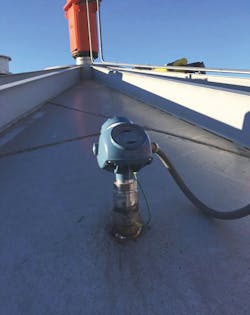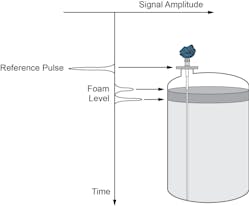According to the U.S. Department of Energy, fuel ethanol production in 2018 exceeded 15 billion gallons for use as a gasoline additive. Nearly 90% of that is produced from corn using a dry milling technique where corn is ground into flour and put through a fermentation and distillation process. This is a highly competitive and narrow margin industry, so producers are always seeking to maintain the highest production levels while looking for ways to cut costs and remain profitable.
A typical dry milling facility produces around 140 million gallons of ethanol per year as its primary product — along with dry distiller’s grain, corn oil and food-grade CO2 as byproducts. The process is straightforward: corn is ground into coarse flour, cooked in water to release starches, and enzymes are then added to convert starches to glucose. In the fermenters, yeast turns the glucose into ethanol and CO2. Ethanol is separated from the mash using distillation, and then remaining water is extracted using a molecular sieve. Three pounds of corn produces about 1 pound of ethanol and 1 pound of CO2 and leaves about 1 pound of grain residue.
While plant engineers keep all the steps of the process under constant evaluation in an effort to find greater efficiencies, the fermenting tanks had long been subject to intense study as the most severe production bottleneck. This facility has seven identical fermenters, each 50 feet in diameter and 55 feet tall. Building another fermenter would cost at least $3 million, so there is a strong incentive to avoid this capital outlay.
Many factors have been examined as parts of the fermenter capacity puzzle, but it turned out that one simple question emerged as a critical element: “How full are we filling the tanks?”
Looking at how the process works explains why this is such a pivotal question.
Continuous batch processing
Ethanol production at this scale is a continuous batch process. Early stages of the process — milling the corn, cooking it and getting it ready for the fermenters — are continuous. The mash gets pumped into the first open fermenter and then is routed to the second when the first is filled, and so on. By the time the seventh is filled, enough time should have elapsed for fermentation in the first fermenter to be complete and its contents sent on to distillation. This sequential filling and emptying process goes on continuously.
The milling and mash production rate must correspond with residence time in the fermenters to allow full conversion to ethanol or close to it. This presents a clear tradeoff for production planners: increasing volume ends up sacrificing time in the fermenters and reduces ethanol yield, whereas increasing fermentation time to boost yield reduces overall volume. Finding the optimal point in between is the ultimate goal. But there is a third element: tank filling level, which can help or hurt both sides of the equation. If every fermenter is not filled to the maximum every time, the plant loses capacity.
Understanding level measurement
Each fermenter has a differential pressure (DP) level transmitter. This is a common level measuring technology and is an ideal choice, provided the liquid involved has known density characteristics that do not vary. Unfortunately, when making mash for ethanol, density is not predictable. Moreover, when the mash goes into the fermenter, there is always some foam, but the amount varies based on a number of factors.
For those reasons, the DP level transmitters did not provide the degree of precision needed without cumbersome density compensation. Getting the last bit of capacity required a different technology: guided-wave radar (GWR).With GWR, a metal probe extends down through the air or vapor space and into the process medium. The probe helps concentrate the signal, which helps when there are multiple levels, such as liquid below foam, or where there is an interface level, such as oil on top of water. GWR devices are easy to install and can be used in tanks of all sizes. The main drawback of GWR is the probe itself, making its use impractical if there are moving agitators or other equipment inside the tank.
For this application, the GWR transmitters are mounted on each fermenter roof (as shown in Figure 1), and the sensor probe only extends 8 feet into the tank. The short measuring probe is more than enough to reach the top of the liquid under normal circumstances while staying clear of the agitators.
When both measuring technologies became available, operators began analyzing the standard procedures for filling the fermenters. The new GWR transmitters provided a much different picture of what was happening in the tank. The first adjustment was understanding their capability to read the height of the foam in addition to the liquid (see Figure 2).This is important as operators do not want to overfill the tanks, forcing foam into the CO2 collection system. GWR’s ability to read the thickness of the foam layer also allows plant operators to characterize conditions where foam tends to develop the most.
Initially, the plant’s operators spent a lot of time analyzing what they were seeing when comparing the DP and GWR measurements to each other. It did not take long to realize that they had been consistently underfilling the fermenters. Following normal operating procedures based on just the DP level instruments, they were routinely leaving several feet of open headspace. After operating for a few months, they calculated the average underfill was 55 inches in tanks where 1 inch represents more than 1,200 gallons. Somewhere between 8% and 10% of available capacity was going unused in the section of the process believed to be the bottleneck.
Realizing the benefits
Obviously, the biggest improvement realized by using the GWR level transmitters is the additional fermenter capacity as just mentioned. Based on the filling and emptying process, putting more in each tank means that it takes longer to fill each, so the total cycle of filling all seven fermenters takes longer. This allows extended fermentation time, resulting in higher yield without reducing volume. It may also allow operators to increase production in the mashing operation.
There are also more subtle improvements to increase profitability. With more accurate volume measurement, it is possible to add enzymes and yeast more precisely, rather than wasting money overdosing additives to be on the safe side.
Also, with a known volume from the GWR and liquid weight from the DP transmitter, it is possible to calculate the specific gravity at the time the mash is pumped into the fermenter. This information can be used to optimize the mash-making process.
And, with the ability to determine specific gravity, it is possible to monitor the fermentation process more closely to determine the optimal residence time in the fermenters. This supports ongoing analysis to characterize the fermentation itself and evaluate the practicality of increasing production without sacrificing ethanol yield.
ROI: The bottom line
The return on investment (ROI) from this upgrade is easy to see. The entire project cost — buying and installing GWR transmitters on all seven fermenters — totaled about $30,000. The result was additional capacity valued at $8 million in the first year. Payback time was less than one week, and it closed the discussion of adding a new fermenter.
The ability to recognize and capture this lost capacity adds to the plant’s profitability and provides an opportunity to move to the next item on the list of efficiency issues.
Lydia Miller, product manager for Emerson’s Rosemount level products, joined the company in 2011 and works with a focus on radar and ultrasonic instruments and level switches. She is also experienced in air-to-air energy recovery for process industries and HVAC applications. Miller holds a bachelor’s degree in mechanical engineering and English from the University of Minnesota.





